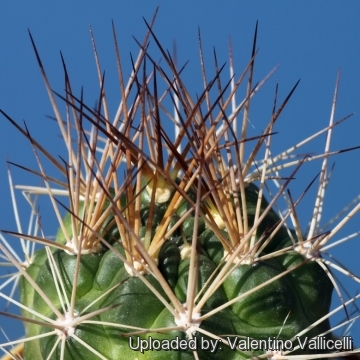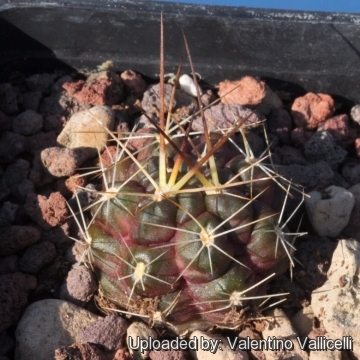




Your support is critical to our success.
Accepted Scientific Name: Rebutia fidaiana (Backeb.) D.R.Hunt
Bradleya 5: 94 (1987)

Origin and Habitat: South of Bolivia departments of Chuquisaca and Potosi
Altitude: 3000 to 3950 meters.
Tipe locality: Cuchu Ingenic, 25 miles south of Potosi.
Synonyms:
- Rebutia fidaiana var. westii (Hutchison)
- Gymnocalycium westii Hutchison
- Sulcorebutia westii (Hutchison) F.H.Brandt
- Weingartia westii (Hutchison) Donald
Rebutia fidaiana (Backeb.) D.R.Hunt
Bradleya 5: 94 (1987)
Synonymy: 18
- Rebutia fidaiana (Backeb.) D.R.Hunt
- Echinocactus fidaianus (Backeb.) Backeb.
- Gymnocalycium fidaianum (Backeb.) Hutchison
- Spegazzinia fidaiana Backeb.
- Sulcorebutia fidaiana (Backeb.) F.H.Brandt
- Weingartia fidaiana (Backeb.) Werderm.
- Rebutia fidaiana var. lecoriensis (Cárdenas)
- Sulcorebutia lecoriensis (Cárdenas) F.H.Brandt
- Weingartia lecoriensis Cárdenas
- Weingartia westii var. lecoriensis (Cárdenas) Donald
- Rebutia fidaiana var. vilcayensis (Cárdenas)
- Sulcorebutia vilcayensis (Cárdenas) F.H.Brandt
- Weingartia vilcayensis Cárdenas
- Weingartia westii var. vilcayensis (Cárdenas) Donald
- Rebutia fidaiana var. westii (Hutchison)
- Gymnocalycium westii Hutchison
- Sulcorebutia westii (Hutchison) F.H.Brandt
- Weingartia westii (Hutchison) Donald
Rebutia fidaiana subs. cintiensis (Cárdenas) D.R.Hunt
Cactaceae Consensus Init. 4: 7. 1997 [Oct 1997]
Synonymy: 4
- Rebutia fidaiana subs. cintiensis (Cárdenas) D.R.Hunt
- Sulcorebutia cintiensis (Cárdenas) F.H.Brandt
- Weingartia cintiensis Cárdenas
- Weingartia fidaiana subs. cintiensis (Cárdenas) Donald
Description: Weingartia westiiSN|14935]]SN|14935]] is a very spiny and usually simple cactus.
Stem: About 10 to 20 cm tall, 6 to 20 cm in diameter, spherical to short-columnar, yellowish-green, grey-green or purple tinged and connected though a thin neck to the strong tuberous root.
Ribs: Completely divided into round spiralling tubercles.
Areole: Large, felted and somewhat raised.
Spines: Very dense, acicular, spreading, thin, elastic, interlacing and almost completely covering the stem, not easily distinguishable as centrals and radials creamy-grey, straw-coloured to brownish..
Central pines: 3-4, up to 6 cm long.
Radial spines: 7-9 similar to the central up to 4 cm long.
Flowers: One per areole nearly apical, approx 4- 5 cm tall 3,5-4,5 cm in diameter, narrow funnel-shaped with short tube, tepals yellow (occasionally white) with a neat staminal throat ring.
Blooming season: Spring to early summer and remain open for five or six days.
Fruit: Small, spherical-ovoidal or tear-drop-shaped, olive green to tannish-brown, thin-skinned at maturity, dehiscing basally or on the side, with few seeds.
Seed: Cap-shaped, nearly as broad as long, black, finely areolate-papillale.
Subspecies, varieties, forms and cultivars of plants belonging to the Rebutia fidaiana group
 Rebutia fidaiana (Backeb.) D.R.Hunt: It has 3-4 central spines up to 5 cm long. Radial spines 9-14, curving up to 3 cm long. Distribution: Potosi and Chuquisaca, Bolivia.
Rebutia fidaiana (Backeb.) D.R.Hunt: It has 3-4 central spines up to 5 cm long. Radial spines 9-14, curving up to 3 cm long. Distribution: Potosi and Chuquisaca, Bolivia. Rebutia fidaiana subs. cintiensis (Cárdenas) D.R.Hunt: It has 13-14 spines, indistinguishable as centrals and radials. Distribution: Chuquisaca.
Rebutia fidaiana subs. cintiensis (Cárdenas) D.R.Hunt: It has 13-14 spines, indistinguishable as centrals and radials. Distribution: Chuquisaca. Rebutia fidaiana var. lecoriensis (Cárdenas): the spines are longer and radiate more outwardly than the regular R. fidaiana also the flowers are slightly different. Distribution: Chuquisaca and Potosi.
Rebutia fidaiana var. lecoriensis (Cárdenas): the spines are longer and radiate more outwardly than the regular R. fidaiana also the flowers are slightly different. Distribution: Chuquisaca and Potosi.- Rebutia fidaiana var. vilcayensis (Cárdenas)
 Rebutia fidaiana var. westii (Hutchison): Has 3-4 central spines up to 6 cm long and 7-9 radial spines similar to the central up to 4 cm long. Distribution: Chuquisaca and Potosi.
Rebutia fidaiana var. westii (Hutchison): Has 3-4 central spines up to 6 cm long and 7-9 radial spines similar to the central up to 4 cm long. Distribution: Chuquisaca and Potosi.
Bibliography: Major references and further lectures
1) James Cullen, Sabina G. Knees, H. Suzanne Cubey “The European Garden Flora Flowering Plants: A Manual for the Identification of Plants Cultivated in Europe, Both Out-of-Doors and Under Glass” Cambridge University Press, 11/Aug./2011
2) David Hunt, Nigel Taylor “The New Cactus Lexicon” DH Books, 2006
3) Edward F. Anderson “The Cactus Family” Timber Press, 2001
4) Augustin K.: "Weingartia: history, description and reclassification." Cactus & Co. 7. (2): 91-126, 2003
5) Ritter Fr.: "Kakteen in Südamerika" Spangenberg, 1980
6) Anderson E. F.: "The Cactus Family" Timber Press, Portland, Oregon, 2001
7) Urs Eggli, Leonard E. Newton: "Etymological Dictionary of Succulent Plant Names" Springer, Berlin/Heidelberg 2010

Rebutia fidaiana var. westii Photo by: Valentino Vallicelli

New spines at the end of winter-early spring. Photo by: Valentino Vallicelli
Cultivation and Propagation: Full sun to light shade, Water regularly in summer but do not overwater. Keep dry or slightly moist in winter at a minimum temperature of 5°C (But Hardy to -4°C or less). This mountain cactus - because of the elongated fat taproot - necessitate deep pots and a well drained mineral potting mix. It is better that they are repotted regularly. Repotting will increase size of stems and the number of flowers produced. Repot yearly until reaching about 100 mm in size, then every two or three years will suffice. Repotting is best done at the end of winter but can be done at other times. Do not water for a couple of weeks after repotting to reduce risk of root rot via broken roots. Need a sufficient amount of air.
Pest & diseases: Keep their roots free of mealy bugs, as fungal attack often occurs as a result of damage to stems by insects. A layer of grit on the surface of the compost prevents moisture from accumulating around the base of the stems and minimise the chance of fungal attack on the roots.
Propagation: Usually by seeds, but also offsets (seldom available), and grafting . Grafted plants in culture are most common and sprout easily. But it is also feasible to root them but they grow much slower on their own roots and takes various years prior to they bloom.
| Your Actions | |
|---|---|
| Back to Rebutia index | |
| Back to Cactaceae index | |
 |
Back to Cacti Encyclopedia index |
Privacy stantement - Terms and conditions - How to cite - About us - Feedback - Donate



